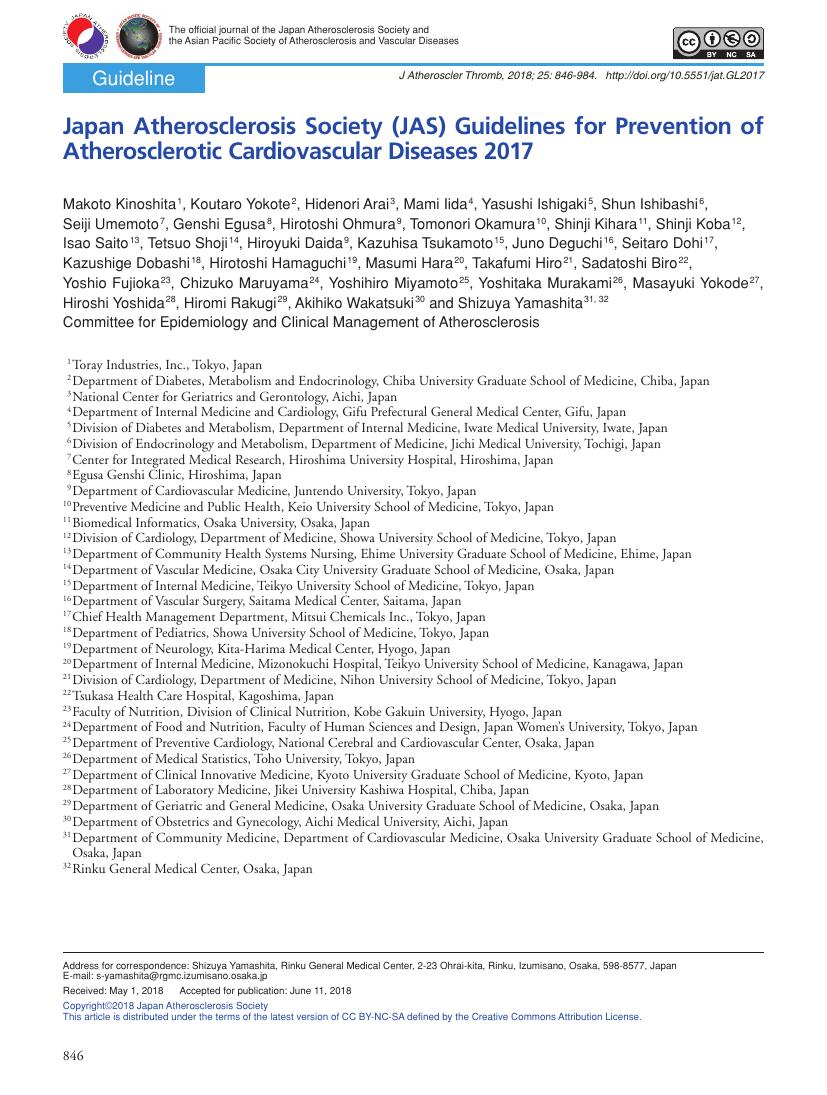- 著者
- Makoto Kinoshita Koutaro Yokote Hidenori Arai Mami Iida Yasushi Ishigaki Shun Ishibashi Seiji Umemoto Genshi Egusa Hirotoshi Ohmura Tomonori Okamura Shinji Kihara Shinji Koba Isao Saito Tetsuo Shoji Hiroyuki Daida Kazuhisa Tsukamoto Juno Deguchi Seitaro Dohi Kazushige Dobashi Hirotoshi Hamaguchi Masumi Hara Takafumi Hiro Sadatoshi Biro Yoshio Fujioka Chizuko Maruyama Yoshihiro Miyamoto Yoshitaka Murakami Masayuki Yokode Hiroshi Yoshida Hiromi Rakugi Akihiko Wakatsuki Shizuya Yamashita Committee for Epidemiology and Clinical Management of Atherosclerosis
- 出版者
- Japan Atherosclerosis Society
- 雑誌
- Journal of Atherosclerosis and Thrombosis (ISSN:13403478)
- 巻号頁・発行日
- vol.25, no.9, pp.846-984, 2018-09-01 (Released:2018-09-01)
- 参考文献数
- 999
- 被引用文献数
- 347 534
- 著者
- Seiji Umemoto Uran Onaka Reo Kawano Atsuko Kawamura Sayaka Motoi Naoki Honda Hiroki Kanazashi Makoto Mitarai for the J-DASH Diet Study Group
- 出版者
- Japan Atherosclerosis Society
- 雑誌
- Journal of Atherosclerosis and Thrombosis (ISSN:13403478)
- 巻号頁・発行日
- pp.57802, (Released:2020-12-09)
- 参考文献数
- 40
- 被引用文献数
- 8
Aim: The Dietary Approaches to Stop Hypertension (DASH) diet is recommended for lowering blood pressure (BP). Our previous single-arm trial revealed that the Japanese cuisine-based DASH (J-DASH) diet (supplying NaCl 8.0 g per day) reduced BP and improved cardiometabolic biomarkers. The present study's primary objective was to test the feasibility of the J-DASH diet based on its effects on the BP and BP variability of subjects with untreated high-normal BP or stage 1 hypertension. Methods: The 6-month study period was held from December 2015 to August 2016. The participants were recruited through advertisements in local newspapers and our website and from among randomized participants at Yamaguchi University Hospital. The 2-month treatments included the following: the J-DASH-1 diet 1×/day or the J-DASH-2 diet providing a fish hamburger-patty 2×/day (5 days/week respectively). The control group consumed their usual diets. For the subsequent 4 months, all participants consumed their usual diets. The main outcome measure was the feasibility of the J-DASH diet. We also collected the data of clinic BP and home BP (by automatic BP monitor), cardiometabolic biomarkers, and lifestyle and psychosocial parameters during the intervention phase. We examined behavior changes throughout the study period, and the diets' safety. Results: Fifty-one participants were recruited; following screening, 48 met the inclusion criteria and were randomized by central allocation. Eight participants were eliminated based on exclusion criteria, and the 40 participants were randomly allocated to the J-DASH 1 and J-DASH 2 groups (n=13 each) and the usual-diet group (n=14). The participants' mean age was 50 years, and 44% were women. The three groups' clinic BP values were not significantly different, but the home BP values were lower in the J-DASH 1 group and lowest in the J-DASH 2 group compared to the usual-diet group and differed significantly among the three groups throughout the study period (p<0.0001). The home BP variability was significantly lower in the J-DASH groups compared to the usual-diet group throughout the study period (p<0.01). The other indices including fish oil showed little differences among the groups throughout the study period. Conclusions: The J-DASH diet was feasible to improve home BP and stabilize its variability, and it did so more effectively than the participants' usual diets.
- 著者
- Seiji Umemoto Uran Onaka Reo Kawano Atsuko Kawamura Sayaka Motoi Naoki Honda Hiroki Kanazashi Makoto Mitarai
- 出版者
- Japan Atherosclerosis Society
- 雑誌
- Journal of Atherosclerosis and Thrombosis (ISSN:13403478)
- 巻号頁・発行日
- vol.29, no.2, pp.152-173, 2022-02-01 (Released:2022-02-01)
- 参考文献数
- 40
- 被引用文献数
- 1 8
Aim: The Dietary Approaches to Stop Hypertension (DASH) diet is recommended for lowering blood pressure (BP). Our previous single-arm trial revealed that the Japanese cuisine-based DASH (J-DASH) diet (supplying NaCl 8.0 g per day) reduced BP and improved cardiometabolic biomarkers. The present study’s primary objective was to test the feasibility of the J-DASH diet based on its effects on the BP and BP variability of subjects with untreated high-normal BP or stage 1 hypertension. Methods: The 6-month study period was held from December 2015 to August 2016. The participants were recruited through advertisements in local newspapers and our website and from among randomized participants at Yamaguchi University Hospital. The 2-month treatments included the following: the J-DASH-1 diet 1×/day or the J-DASH-2 diet providing a fish hamburger-patty 2×/day (5 days/week respectively). The control group consumed their usual diets. For the subsequent 4 months, all participants consumed their usual diets. The main outcome measure was the feasibility of the J-DASH diet. We also collected the data of clinic BP and home BP (by automatic BP monitor), cardiometabolic biomarkers, and lifestyle and psychosocial parameters during the intervention phase. We examined behavior changes throughout the study period, and the diets’ safety. Results: Fifty-one participants were recruited; following screening, 48 met the inclusion criteria and were randomized by central allocation. Eight participants were eliminated based on exclusion criteria, and the 40 participants were randomly allocated to the J-DASH 1 and J-DASH 2 groups ( n=13 each) and the usual-diet group (n=14). The participants’ mean age was 50 years, and 44% were women. The three groups’ clinic BP values were not significantly different, but the home BP values were lower in the J-DASH 1 group and lowest in the J-DASH 2 group compared to the usual-diet group and differed significantly among the three groups throughout the study period (p<0.0001). The home BP variability was significantly lower in the J-DASH groups compared to the usual-diet group throughout the study period ( p<0.01). The other indices including fish oil showed little differences among the groups throughout the study period. Conclusions: The J-DASH diet was feasible to improve home BP and stabilize its variability, and it did so more effectively than the participants’ usual diets.
